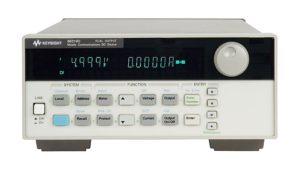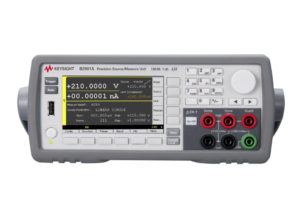Power supplies are normally regarded as simple animals and indeed they are – but with a little bit of thought you can get a lot more performance and functionality from the power supply that you’re using. Howard Peat, distribution sales manager – field sales engineer at Microlease and Martin Dinmore, distribution field engineer at Keysight Technologies, distill a lifetime’s experience of power supplies and power measurements into six quick, easy-to-apply tips
Tip 1: Use remote sensing to compensate for load-lead effects
When a power supply leaves the factory, its regulation sense terminals are usually connected to the output terminals. This limits the supply’s voltage regulation abilities, even with very short leads. The longer the leads and the higher the wire gauge, the worse the regulation becomes. It gets even worse if relays are used to connect power to the load.
Remote sensing, where the sense terminals of the power supply’s internal feedback amplifier connect directly to the load, lets the power supply regulate its output at the load terminals rather than at its own output terminals. It is implemented by disconnecting local sense leads from the output terminals, then using twisted two-wire shielded cable to connect the power supply sensing terminals to the sense points on the load.
 Tip 2: Eliminate noise from low-level measurements
Tip 2: Eliminate noise from low-level measurements
It is easier to eliminate noise than to filter it. Starting with a low-noise supply is naturally a great way to keep noise out of your measurements. Switch-mode supplies can be used successfully if their specifications include a low (<20mA) common-mode current.
The next areas to consider are connections between power supplies and the device under test. Here, conducted noise is minimised by eliminating ground loops, ideally providing only one connection to ground. In rack systems the DC distribution paths need to be separate from other conductive paths that carry ground currents.
Radiated pick-up is reduced by using twisted shielded conductors for the output and remote sense leads. Cable shields should only be connected to ground at one end.
Lower common-mode noise current is achieved by equalising the impedance to ground from plus and minus output terminals. It is also important to equalise the DUT’s impedance to ground from its plus and minus input terminals.
Voltage spikes from the DUT can be prevented by adding a bypass capacitor close to the load, which offers low impedance at the highest testing frequencies.
Tip 3: Use down programming to increase test speed
Power supply output capacitors discharge slowly under light or no load conditions. This becomes problematic when performing tests at varying voltage levels, since slow discharge means slower tests. To ameliorate this, down programming circuits in power supplies rapidly decrease the output voltage and considerably lowering discharge times.
Two types of down programming circuits are significant. In the first, an FET is placed across the output terminals. When the output voltage is higher than the programmed value, the FET activates and discharges the output capacitor. The FET can sink currents between 10 and 20 per cent of the supply’s output current rating, resulting in slight degradation of the down programming current near zero volts. Alternatively, the down programmer is placed between the power supply’s positive terminal and a negative source, which pulls the output completely down with no degradation near zero.
 Tip 4: Simplify setup with autoranging power supplies
Tip 4: Simplify setup with autoranging power supplies
With bench and rack space at a premium, being able to produce a wide range of voltage and currents with one power supply is beneficial, for example allowing DC/DC converters to be tested under several voltage and current combinations at around the same power level.
A basic DC power supply has a rectangular output, having a maximum voltage (Vmax) and current setting (Imax) with a single maximum power point (Pmax=Vmax × Imax). More advanced power supplies have multi-range outputs. Today’s autoranging outputs satisfy many different voltage and current combinations and eliminate the need for many power supplies.
Tip 5: Connect power supplies in series or parallel for higher output
Connecting two or more power supplies in series provides higher voltages. However, it is important to avoid exceeding the floating voltage rating of any of the supplies or subjecting any of the power supplies to negative voltages. Each power supply should be programmed independently to deliver an equal fraction of the total output voltage and limit current to the maximum that the load can safely handle.
Connecting multiple power supplies in parallel provides higher currents, but again there are limitations. One unit must operate in constant voltage (CV) mode and the rest in constant current (CC) mode. The output load must draw enough current to keep CC unit(s) in CC mode.
In modern power supplies outputs can be grouped to create a single output with higher current and power capability.
Tip 6: Use a power supply to measure DUT supply current
Accurately measuring DUT supply currents above 10A is beyond the range of typical DMMs in ammeter mode. One solution is to use an external shunt and the DMM’s voltage mode. Using the power supply itself is better. Many supplies boast an accurate measurement system, including a shunt and can be started via a single command to the power supply. With typical accuracy around ±0.5 per cent or better at full output levels, the advantages of using power sources to measure high currents is clear. Using them to measure low currents may not be so straightforward. Nevertheless, a power supply with multiple range readback caters for most requirements, offering full scale accuracy of 0.04 per cent + 15 µA at low range (100 mA) or 0.04 per cent + 160 µA at high range (3A).
 CIE Components in Electronics
CIE Components in Electronics




